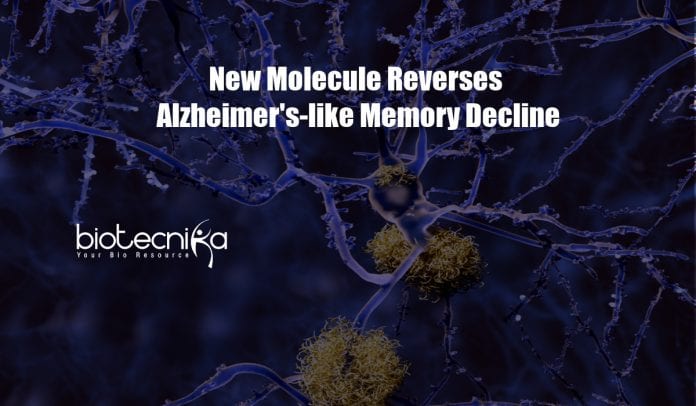New Molecule Reverses Memory Decline – Salk Researchers Study
In a mouse model of inherited Alzheimer’s disease, a drug candidate developed by Salk researchers successfully reversed memory loss, which was previously shown to slow aging in brain cells. The new research revealed that the drug, CMS121, works by changing how brain cells metabolize fatty molecules known as lipids and was published online in the journal Redox Biology.
The senior author of the new paper, a senior staff scientist in the lab of Salk Professor David Schubert, Pamela Maher said, “We are now beginning to pursue clinical trials based on the success of this study. Compared to our previous studies on it, this was a more rigorous test of how well this compound would work in a therapeutic setting.”
Maher, over the last few decades, has studied how memory can be improved and Alzheimer’s-like disease in mice can be prevented by a chemical called fisetin, found in fruits and vegetables. Different variants of fisetin were synthesized by the team more recently and they found that one variant, called CMS121, was especially effective at slowing the degeneration of brain cells and improving the animals’ memory.
The effect of CMS121 on mice that
develop the equivalent of Alzheimer’s disease was tested by Maher and colleagues in the new study. Beginning at 9 months old, the equivalent of middle age in people, Maher’s team gave a subset of the mice daily doses of CMS121, and after the mice have already begun to show learning and memory problems. The researchers say that the timing of the lab’s treatment is similar to how a patient who visits the doctor for cognitive problems might be treated.A battery of memory and behavior tests were given to the mice, both treated and untreated, after three months on CMS121, at 12 months old. In both types of tests, the untreated mice with the disease performed more poorly, while the mice with Alzheimer’s-like disease that had received the drug performed equally well as healthy control animals.
The levels of different molecules within the brains of the three groups of mice were compared by the team to better understand the impact of CMS121. They discovered that mice with the disease had several differences compared to both healthy mice and those treated with CMS121 when it came to levels of lipids, the fatty molecules that play key roles in cells throughout the body.
Differences in something known as lipid peroxidation, the degradation of lipids that produce free radical molecules that can go on to cause cell damage, were pinpointed by the researchers in particular. Compared to healthy mice or those treated with CMS121, mice with Alzheimer’s-like disease were found to have higher levels of lipid peroxidation than either.
The first author of the new paper, Salk postdoctoral fellow Gamze Ates says, “That confirmed that this drug is actually normalizing those changes, and confirmed that lipid peroxidation is altered in Alzheimer’s.”
The researchers also showed that CMS121 lowered levels of lipid peroxidation as it lowered levels of a lipid-producing molecule called fatty acid synthetase (FASN).
The group found that the patients had higher amounts of the FASN protein than similarly aged controls who were cognitively healthy, when they analyzed levels of FASN in brain samples from human patients who had died of Alzheimer’s, which indicates that for treating Alzheimer’s disease, FASN could be a drug target.
The research group hopes other researchers will explore additional compounds that may treat Alzheimer’s by targeting FASN and lipid peroxidation while the group is pursuing clinical trials.
Maher says, “Identifying a new target in an unbiased way like this opens lots of doors and is really exciting as there has been a big struggle in the field right now to find targets to go after.”
Source
New Molecule Reverses Memory Decline






























